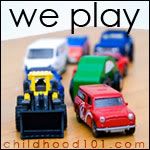Sunday was a chilly but sunny day here in Melbourne and, inspired by a recent post by SquiggleMum, called "Playing Whatever the Weather", I decided to let the children play outside despite the cold. I am what my family refers to as a 'cold body', so I really don't like being outside in winter, but thankfully my kids are big enough (and the windows looking out the back are large enough) that I don't necessarily have to be out there with them.
They had a ball. They spent the morning chasing each other up and down the hill we have in the yard on their bikes. Then, after some lunch and a much-needed rest, Em asked to do some painting (Ed had fallen asleep).
I try to minimise mess and cleaning up after the kids paint, so I headed straight to my very messy art cupboard to raid the recycling items I keep there. I grabbed an egg carton to pour the paint into and a large glass jar to hold the water for the brushes.
Next I set up a plastic table I bought from a cheapy shop that can get as painty and grotty as it likes because it lives outside. That's where I put the paint, the jar and a dishwashing cloth for Em to dab her brush onto after she had finished washing it off. I set all of this up alongside her easel.

I took my clothes airer and some pegs out too to hang the wet paintings on.
Em asked for a pencil and eraser to sketch what she wanted to paint.

She must have been inspired by her beautiful outlook.


It wasn't long before sleepy Ed came out from his room and Em decided she wanted to paint his portrait. But Ed just wouldn't stand still long enough.

Then surprise, surprise, Ed wanted to paint too.
I was a bit stuck because I don't have 2 easels, but he soon decided he wanted to do "foldy" paintings, so we didn't need an extra easel after all.
I made a makeshift table for him using an upside down storage container with an esky lid as a table top.
I got him some cotton tips, a bag to throw the tips into when he had finished and some plain white paper which I pre-folded. Once they were set up, I headed back to my ironing.
It wasn't long before hands were being painted, so I went back out with some warm soapy water, a facewasher and an old hand towel.
The two of them painted outside by themselves for over an hour. Because the activity was so open ended, it suited both of their developmental needs and abilities. Em painted masterpieces and her hands and started to fold her large paper in half. Ed mostly experimented with colour mixing and colour squishing.
Cleaning up was easy, most of it went straight into the bin, then we left the paintings to dry outside. A simple, creative, fun afternoon.
Don't forget to checkout my "You Tube" video if you haven't already and play along at the Childhood 101 "We Play" link up.






